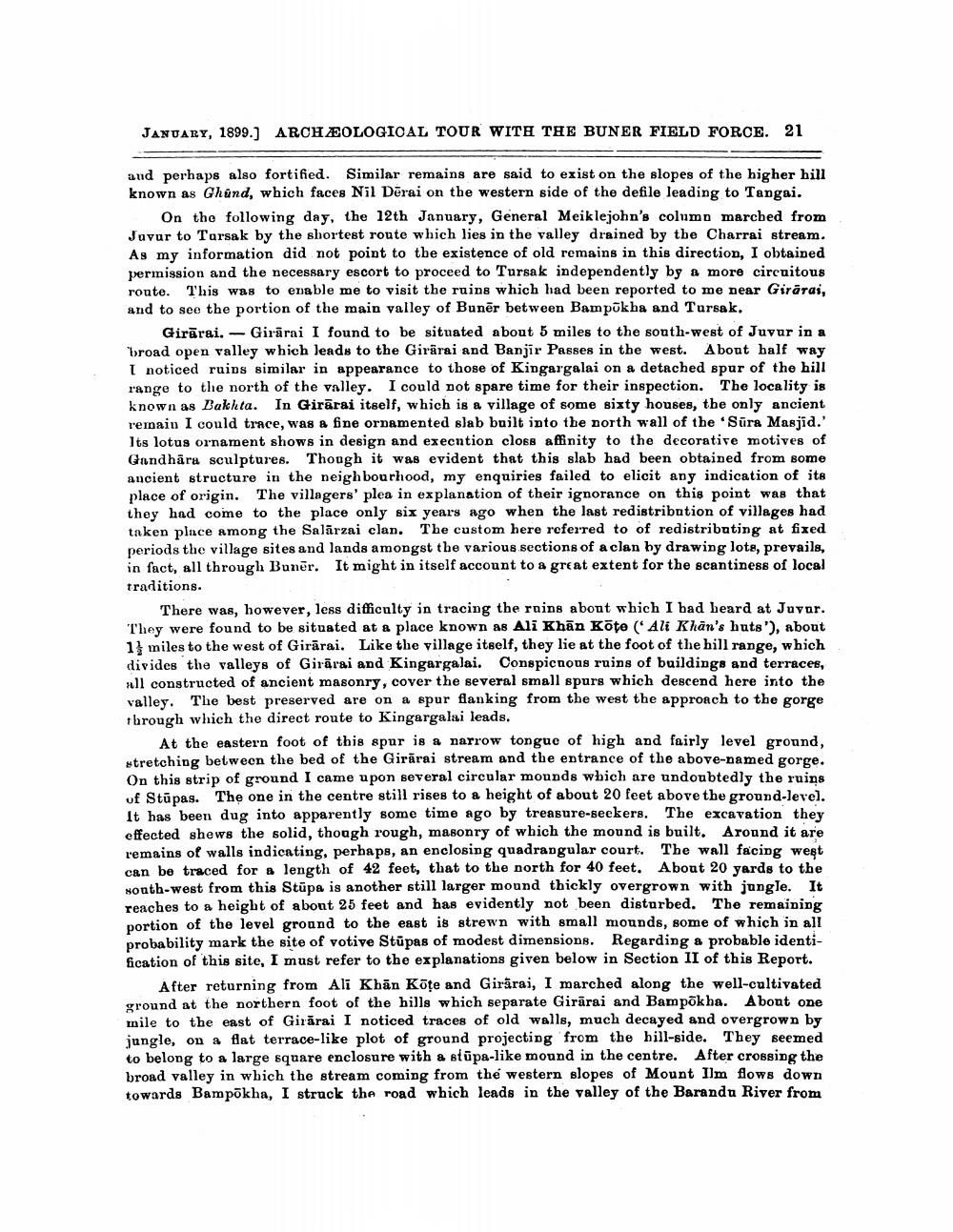________________
JANUARY, 1899.) ARCHÆOLOGICAL TOUR WITH THE BUNER FIELD FORCE. 21
aud perhaps also fortified. Similar remains are said to exist on the slopes of the higher hill known as Ghund, which faces Nil Dērai on the western side of the defile leading to Tangai.
On the following day, the 12th January, General Meiklejohn's column marched from Javur to Tarsak by the shortest route which lies in the valley drained by tbe Charrai stream. As my information did not point to the existence of old remains in this direction, I obtained permission and the necessary escort to proceed to Tursak independently by a more circuitous route. This was to enable me to visit the ruins which had been reported to me near Girārai, and to see the portion of the main valley of Bunēr between Bampükha and Tursak.
Girārai. - Girārai I found to be situated about 5 miles to the south-west of Juvur in a broad open valley which leads to the Girārai and Banjir Passes in the west. About half way I noticed ruins similar in appearance to those of Kingargalai on a detached spur of the hill range to the north of the valley. I could not spare time for their inspection. The locality is known as Bakhta. In Girārai itself, which is a village of some sixty houses, the only ancient remain I could trace, was a fine ornamented slab built into the north wall of the 'Sūra Masjid.' Its lotus ornament shows in design and execntion clots affinity to the decorative motives of Gandhāra sculptures. Though it was evident that this slab had been obtained from some ancient structure in the neighbourhood, my enquiries failed to elicit any indication of its place of origin. The villagers' plea in explanation of their ignorance on this point was that they had come to the place only six years ago when the last redistribution of villages had taken place among the Salārzai clan. The custom here referred to of redistributing at fixed periods the village sites and lands amongst the various sections of a clan by drawing lote, prevails, in fact, all through Buner. It might in itself account to a great extent for the scantiness of local traditions.
There was, however, less difficulty in tracing the rains about which I had beard at Juvar. They were found to be situated at a place known as Ali Khan Koto (* Ali Khan's huts'), about 1 miles to the west of Girārai. Like the village itself, they lie at the foot of the hill range, which divides the valleys of Girārai and Kingargalai. Conspicnous ruins of buildings and terraces, all constructed of ancient masonry, cover the several small spurs which descend here into the valley. The best preserved are on a spur flanking from the west the approach to the gorge through which the direct route to Kingargalai leads.
At the eastern foot of this spur is a narrow tongue of high and fairly level ground, stretching between the bed of the Girārai stream and the entrance of the above-named gorge. On this strip of ground I came upon several circular mounds wbich are undoubtedly the ruins of Stūpas. The one in the centre still rises to a height of about 20 feet above the ground-level. It has been dug into apparently some time ago by treasure-seekers. The excavation they effected shews the solid, though rough, masonry of which the mound is built. Around it are remains of walls indicating, perhaps, an enclosing quadrangular court. The wall facing west can be traced for a length of 42 feet, that to the north for 40 feet. About 20 yards to the Nouth-west from this Stūpa is another still larger mound thickly overgrown with jungle. It reaches to a height of about 25 feet and has evidently not been disturbed. The remaining portion of the level ground to the east is strewn with small mounds, some of which in all probability mark the site of votive Stūpas of modest dimensions. Regarding a probable identification of this site, I must refer to the explanations given below in Section II of this Report.
After returning from Ali Khan Köte and Girārai, I marched along the well-cultivated ground at the northern foot of the hills which separate Girārai and Bampokha. Abont one inile to the east of Girārai I noticed traces of old walls, much decayed and overgrown by jungle, on a flat terrace-like plot of ground projecting from the hill-side. They seemed to belong to a large square enclosure with a stūpa-like mound in the centre. After crossing the broad valley in which the stream coming from the western slopes of Mount Ilm flows down towards Bampokha, I struck the road which leads in the valley of the Barandu River from




